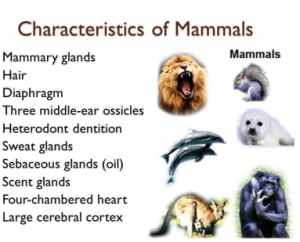Characteristics of mammals

We have said that mammals form a class of living beings with notable differences among themselves. however, they present a series of characteristics that are not present in any other animal species:
List of Characteristics mammals
- Mammary glands: their females have mammary glands which secret milk to feed their babies.
- Hairs: their skin is covered over with hairs.
- Glands: their skin also contains sweat glands, sebaceous glands, and scent glands.
- Teeth: booth upper and lower jaws bear various types of teeth.
- Nails: their fingers bear nails.
- Limbs: they have two pairs of limbs.
- Birth: most mammals give birth to live young ones.
- Warm-blooded: they are warm-blooded animals.
Subgroups: they are divided into three subgroups.
- Egg-laying mammals
- Pouched mammals
- Placental mammals
Classification of mammals

What are viviparous animals?
Viviparous animals are those whose embryo develops, after fertilization, within a specialized structure in the female’s womb, where it will receive oxygen and food until the moment of birth. But viviparism is not unique to mammals. Some reptile insects, fish, and amphibians urodeles are also viviparous.
But the most advanced form of viviparous is placental, which occurs in almost all mammals, with the exception of monotremes, which lay eggs, and marsupials, which lack a placenta, so the fetus is born in a very premature, and must continue its development in an outer pouch called a pouch.
Placental mammals
The placentals ( Placentalia) are an infraclass of mammals. Its distinctive feature is that the offspring remain in the womb, being fed by a placenta, as we have seen before. The gestation period varies greatly from species to species. Normally, the larger the size of the animal, the longer the gestation time.
They are placental mammals:
- Cingulate (armadillo)
- Vermilinguos (anteater)
- Folivores (sloth)
- Tenrecidos (tenrec)
- Chryschlorides (golden mole)
- Macroscelidae (elephant shrew)
- Tubulidentate (aardvark)
- Sirenians (manatee)
- Proboscideans (elephant)
- Procávids (damán)
- Erinaceomorphs (hedgehog)
- Soricomorphs (mole, shrew, Pyrenean desman)
- Artiodactyls (camels, llamas, pigs, hippos, cows, antelopes, deer, giraffes, goats, etc.)
- Cetaceans (whale, dolphin, orca)
- Ceratomorphs (rhinoceros, tapir)
- Hypomorphs (horse, ass, onager, zebra)
- Chiroptera (bat)
- Folidotos (pangolin)
- Carnivores (includes about 260 species)
- Lagomorphs (rabbit, hare, pica)
- Rodents (includes about 2,280 species)
- Scandentios (tupaya)
- Dermopteros (colugo)
- Primates (it is the order to which we humans belong)
The
marsupials (Marsupialia) are underclass mammals. They are characterized by a short development in the maternal uterus and complete much of the growth clinging to the mammary glands inside the marsupial bag or marsupium, a bag located in the mother’s womb. There are about 270 current species, about 70 in America and about 200 in Australia.
Embryos are born at a very early stage of their development and crawl on a line of saliva that the mother deposits with her tongue between the vagina and the marsupial bag; Once the pouch is reached, they are attached to the nipples and remain in the bag for a long time until their development is complete.
They are marsupials:
- Didelfimorphs (possum)
- Paucituberculates (runcho mouse)
- Microbioterios (Monito del Monte)
- Diprotodonts (kangaroo, pygmy phalanger, couscous, koala, glider)
- Dasiuromorphs
- Notorictemorphs (marsupial mole)
- Peramelemorphs (bandicoots, bilbies)
Monotremes
The monotremes are an order of mammals that includes the current species most primitive mammals that hold various reptilian features, such as oviparous (are mammals only that lay eggs), and the presence of sewer hole confluence of the digestive, urinary and player; its name refers to this characteristic and means “a single hole”.
For a long time, they were classified as reptiles with hair until they were unequivocally identified as mammals because they have all the characteristics that define the class (they have hair; they produce milk to feed their young; they have three bones in the middle ear; they maintain their temperature body regardless of ambient temperature)
They are monotremes:
- The platypus
- Echidnas
For Related Topic see: Biology and its Branches